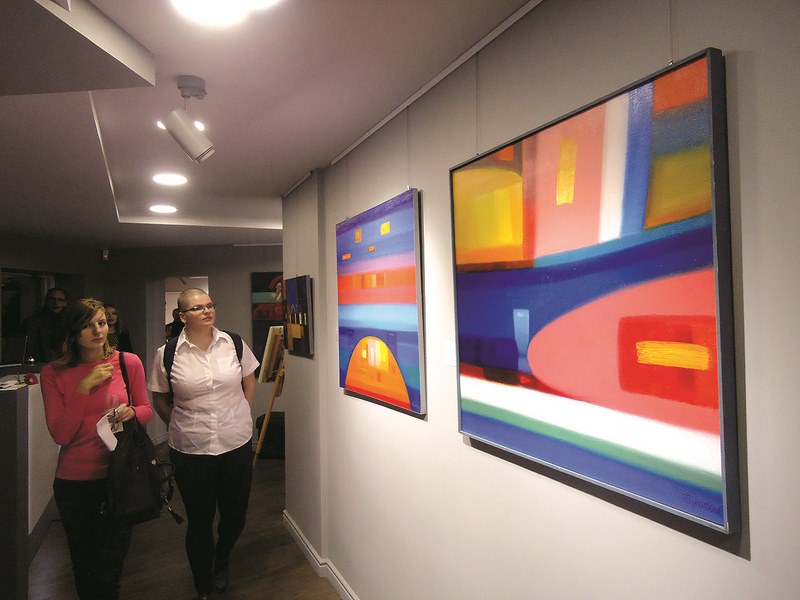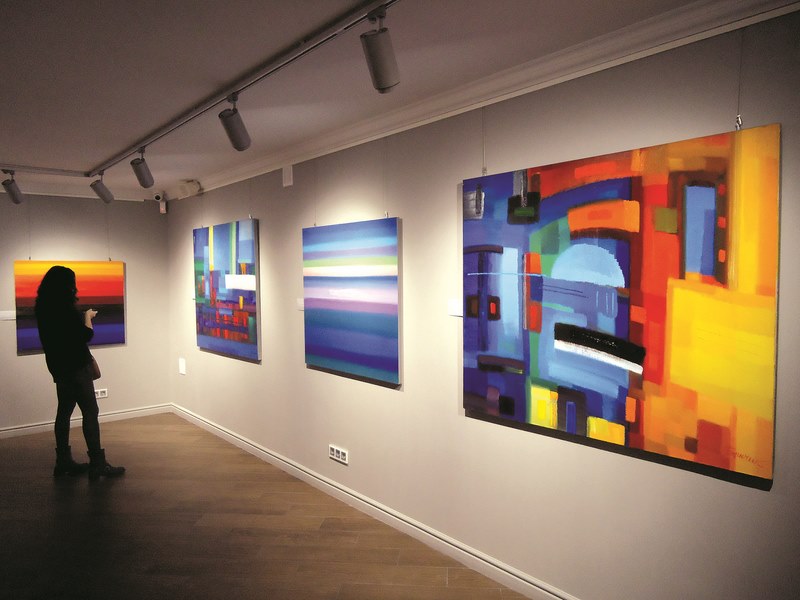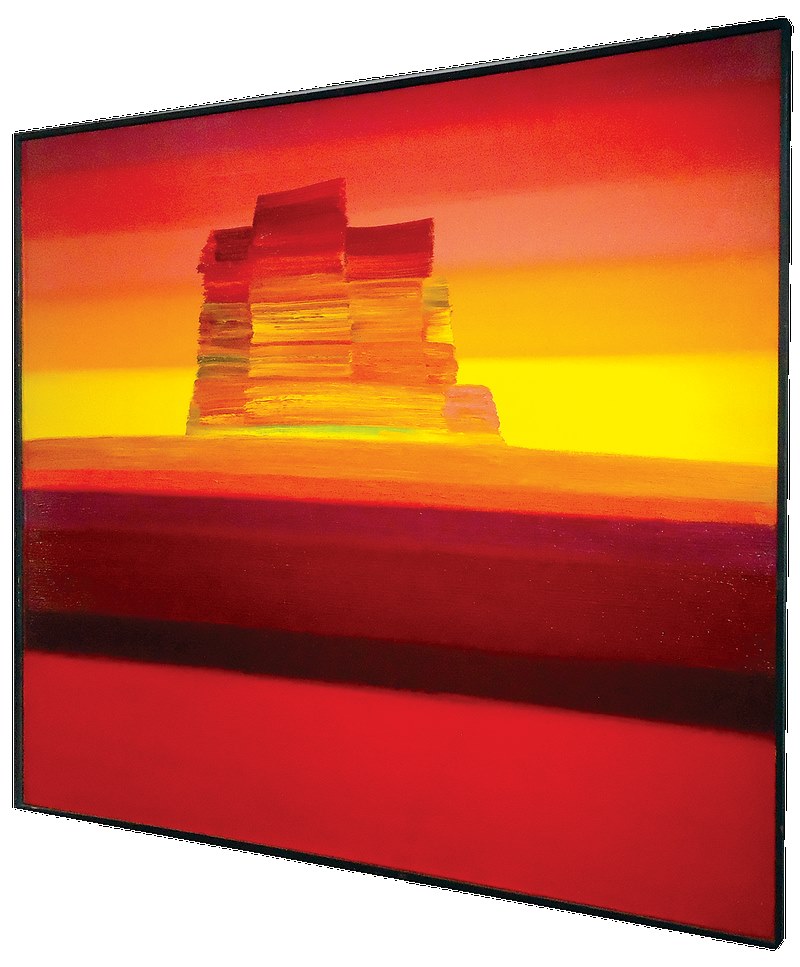Mikalai Bushchik uses colour in an unusual manner, creating sketchy portraits, and ‘childish’ multi-coloured houses and trees. Of course, they are not supposed to appear realistic, rather representing an idea. Experimenting with colour, he creates poetry and musical rhythm, both in oil and watercolours.

Mikalai Bushchik and his impressions
The titles of his works are also interesting, evoking much: Space of Fire uses warm reds to symbolise heat: wide strips represent desert, while the sky is separated by a horizon line, holding a small yellow sun.
Bushchik is a moody artist, creating unusual landscapes: not inventions of the subconscious but representations from his travels. As we know, nature inspires many emotions in our soul.
You can’t help but feel that the gallery is filled with bright colours, despite the subdued lighting. There is an atmosphere of mystery, as if conjuring the depths of the universe. Having entered, you feel as if you must whisper, speaking in murmurs, to avoid breaking the harmony of art. It becomes like a rare bird we might startle and frighten away.

It is said that Bushchik creates impressions rather than images. He explains, “As far back as I can remember, I always liked to paint. At first, I simply copied drawings, but I surprised my parents when I was 5 by painting a true circle. They even took compasses to measure it. When I was 14, I received my first paints, from my grandmother and grandfather. I then began reproducing the canvases of great artists. I’ve always valued classics, seeing their depth of thought and feeling. This has always stayed with me: not so much the outward side of things, but the essence and emotional side.”
Mikalai’s vocabulary does not include the word ‘must’, as he does only what he wishes, choosing his subjects accordingly, seeking answers to eternal questions. His tremendous combinations of colour have always intrigued me, as has his use of space. He seems to think in colour, perceiving emotions and natural phenomenon in this way. He shares past impressions as a traveller rather than abstractions, turning landscapes into luxuriant palettes of colour not usually seen in Belarusian painting.

Rainbow of colours inside gallery exhibition halls
He often makes small sketches to comprehend how higher forces ‘paint’ the world. Sometimes, he sits near the window and reflects upon friends, people and events. He recollects impressions and, sometimes, music, saying,
“I like music with its own style, from classics to modern jazz. I like jazz based on improvisation but not chaotic. Emotions conjure images. I try to bypass destructive elements, as they negate a state of harmony. Where thoughts form a positive ‘line’ of harmony, they become structured.”

He considers art to be organic, representing time. As for masterpieces, he states, “I think that a masterpiece combines the creativity of an artist, composer and poet, representing the time in which they live. Each artist is a pioneer.”
You can’t help but feel that the harmony about which he speaks is his constant state: one of calm. He notes, “You need to stick to your path: be true to yourself. Love life and the concept of ‘love’. All depends on desire and the choices we make. Our soul and mind must work jointly, singing with one voice, whether or not it’s profitable. Good income may bring disharmony, so making choices isn’t easy. Some are greedy, while others are more purposeful. You must choose between a life of satisfaction and internal calm, or generating money, at the cost of satisfaction. Of course, the latter often brings disappointment.”
People always speak of his sense of colour, calling him an ‘outstanding colourist’. His latest works are no exception, being a triumph of sunshine. I do wonder which locations he’s depicting.

Where does all this light come from? Our landscapes are full of greys and browns.
I wanted a new view of myself and a new view for spectators. I wanted to show new compositions: possibilities of the soul.
What has changed in your works?
Time has changed, having its own rhythm, as we feel through our environment, and the impetuosity or calm of people. There is the rhythm of conversation, of relations, of roads, and of our thoughts and online communication. The face of time in rhythm changes, as do our emotions. Each emotion has its colour: hot or cold. I don’t know how best else to explain.

I don’t aspire to gain public acclaim, or to create a chronicle. I create for other reasons: to show the aesthetic and spiritual beginning of time.
I see that you still use your vivid colours.
It’s my attempt to show my impressions of today. The exhibition has its flavour.
Does everything revolve around colour: plot, images and composition?
Certainly. I try, as much as I can. Only the future can decide. These are only my impressions; others may feel differently. I hope they excite others and appear unexpected. After all, an artist portrays what he sees: for me, the harmony of the world, and a feeling of happiness.
I’d like others to see this and take this harmony to heart, rather than watching their action films or tearful soap operas. The world is perfectly harmonious. Even world corporations polluting nature display caution in their decisions, and on problems of poverty. People do tend to think about the future, and about children.
My works are symbolic rather than chronological.
Your watercolours show your travel impressions?
Yes, they are my personal perception, like chamber music. I toured Belarus, Lithuania and Bulgaria. For an artist, travel is life, even if he simply looks out of the window. Watercolours have their own passion, thirsting to show the beautiful gift of life. I’m really surprised when, in painting, I see semi-photographic images rather than emotions. Technique should have its place, since it satisfies the first aesthetic interest, but an artist should express himself, interpreting the soul’s vision, and telling his own story, through the melody of paint. It doesn’t matter whether the work is realistic.
Has travelling been a strong influence over you?
Travel allows us to experience the world as a child, gaining new stimuli. I like to rejoice in such feelings, revisiting a place only when I’ve nearly forgotten it: when only symbolic memories remain. I’m surprised that people paint trees and stones. I prefer something else: people, the Earth, and space.
You’ve always said that culture and art are very different things.
Yes, culture is like the soil, while art is what grows on this soil. Our way of life is culture, while that to which the soul aspires is something light and harmonious: art. Creativity is everything in which we are engaged; how we are engaged in it is art.
Our conversation revealed much about Mikalai Bushchik: not only about his creativity, but about his personality.
By Veniamin Mikheev
























